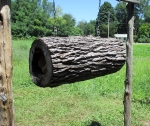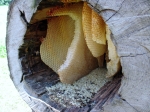Unable to attend the first two Steller Apiaries Annual Alternative Beekeeping Picnic, we managed this last July 13th to appear at the third but even then had to cut short our attendance. As a result we saw only two of the many scheduled demonstrations and displays.
|
While mainly using Kenyan-style hives the Stellers also experiment with other non-Langstroth types such as this take on a Karakovan log hive, the first exhibit of the day. When we remarked that it seemed easier to construct than most other hives, Keith Steller chuckled and replied that it was easy indeed for the local ants had hollowed the log. He only had to construct loose-fitting end-caps and a sturdy frame from which to suspend the log. Then, of course, the ants were evicted and the honeybees installed. The cap at one end was briefly removed to display the comb within, running the length of the log. The brood chamber was near the other end with this end mostly honey. As the picture shows, beekeepers had been nibbling at it as Keith demonstrated by reaching in and breaking off another small piece to pass around. Although the end cap shown (at the brood end) has an entrance hole, the bees also used any suitably sized gaps between the log body and either end-cap. Thus foragers could deliver nectar at the other without needing to traverse the length of the log. This is also why we have stitched the sides of our hives with entrance holes along their length. |
Having mentioned ants just now, we should also pass along a tip from Jessica Steller. She uses cinnamon powder dumped directly into the hive to repel ants. It seems to not bother the bees although they probably remove it as trash in their own time.
|
In deference to those like us who could not stay for the entire event, the Stellers graciously rescheduled what would have been the grand finale to become the second exhibit of the day, an observation hive built into a wall. The wall in question is something of an exterior wall, separating an enclosed but unheated porch from the interior of the house. The drywall on each side was removed between a pair of studs near the room corner and the space framed. Entrances (hard to see in the picture) were provided by drilling holes (one near the ceiling, one near the floor) through studs to the outside and running plastic tubing to provide short tunnels for the bees. Then a window and shutter on each side finished it. Conceptually simple and executed with Keith’s usual neat handiwork. We worried that warmth from the house would keep the bees more active during winter, possibly never entering cluster, and so they would deplete their stores too quickly to last until springtime. Keith agreed and admitted that they were saving honey to feed this one hive even though the others are expected to manage their stores without human assistance. These bees built their comb on either side of the hive rather than from the top. Not at all typical, even in observation hives. Yet another example of ignorant bees not knowing how they are supposed to behave. Tongue firmly in cheek on that last sentence. |
And with that we had to depart as the mead brewing demonstration was beginning. Also to follow were demonstrations of other typical beekeeper activities such as honey extraction, wax melting, and hive inspection in a horizontal hive. We most regret missing that last so we could compare our bungling to what should be done. Perhaps at a Fourth Annual Alternative Beekeeping Picnic.





2013 July 28 at 04:01
I want to put an observation hive in my wall. That is sooooooo cool!
2013 July 28 at 20:33
You may be sure that everyone who saw it was trying to think of a likely spot in his own walls.
And your location would not have the winter worries.
2013 August 16 at 17:35
I would love to have an observation hive at home – more interesting than a goldfish bowl – although some visitors still have difficulty with the wall-sized pictures of bees…
2013 August 16 at 17:54
That would make the shutters even more important. The bees prefer the darkness and the phobic very much prefer not to see the bees.
“Emma, is your closet humming?”
2013 August 16 at 17:55
I don’t think so *looks around*…
2013 August 17 at 23:05
Karakovan hive is pretty cool, but it’s going to be tough to get the honey.
2013 August 18 at 04:03
Good point. It seems the procedure is to heavily smoke the bees off the comb and cut it out.
Click to access BfDJ94%20Harvesting%20honey%20from%20a%20log%20hive.pdf
But the Stellers may be using this hive to house a colony just for preservation’s sake and fun. We must ask next time.